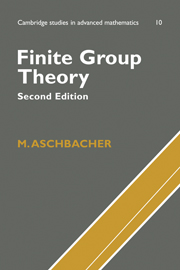Book contents
- Frontmatter
- Contents
- Preface
- 1 Preliminary results
- 2 Permutation representations
- 3 Representations of groups on groups
- 4 Linear representations
- 5 Permutation groups
- 6 Extensions of groups and modules
- 7 Spaces with forms
- 8 p-groups
- 9 Change of field of a linear representation
- 10 Presentations of groups
- 11 The generalized Fitting subgroup
- 12 Linear representations of finite groups
- 13 Transfer and fusion
- 14 The geometry of groups of Lie type
- 15 Signalizer functors
- 16 Finite simple groups
- Appendix
- References
- List of Symbols
- Index
14 - The geometry of groups of Lie type
Published online by Cambridge University Press: 05 June 2012
- Frontmatter
- Contents
- Preface
- 1 Preliminary results
- 2 Permutation representations
- 3 Representations of groups on groups
- 4 Linear representations
- 5 Permutation groups
- 6 Extensions of groups and modules
- 7 Spaces with forms
- 8 p-groups
- 9 Change of field of a linear representation
- 10 Presentations of groups
- 11 The generalized Fitting subgroup
- 12 Linear representations of finite groups
- 13 Transfer and fusion
- 14 The geometry of groups of Lie type
- 15 Signalizer functors
- 16 Finite simple groups
- Appendix
- References
- List of Symbols
- Index
Summary
Chapters 4 and 7 introduced geometries preserved by the classical groups. Chapter 14 considers these geometries (and related geometries preserved by Coxeter groups) in detail, and uses the representations of the classical groups on their geometries to establish various group theoretical results.
For example we'll see that the finite classical groups Ln(q), Un(q), PSpn(q), and are simple, with a few exceptions when n and q are small. Also Ln(F) and PSpn(F) are simple for infinite fields F, as are Un(F) and PΩn(F) under suitable restrictions on F. If F is finite of characteristic p, it will develop that the stabilizer B of a maximal flag of the geometry of a classical group G over F is the normalizer of a Sylow p-group of G, and the subgroups of G containing B are precisely the stabilizers of flags fixed by B. These subgroups and their conjugates are the parabolic subgroups of G. We say B is the Borel group of G.
It also turns out that to each classical group G there is associated a Coxeter group called the Weyl group of G. The Weyl groups of the classical groups are of type An, Cn, or Dn. The structure of G is controlled to a large extent by that of its Weyl group: see for example lemma 43.7 and Exercise 14.6.
- Type
- Chapter
- Information
- Finite Group Theory , pp. 209 - 228Publisher: Cambridge University PressPrint publication year: 2000



